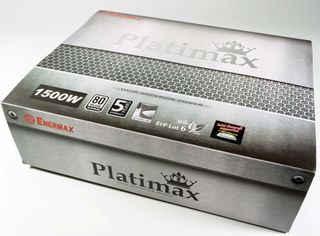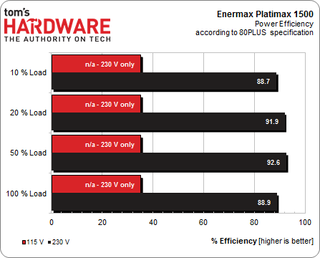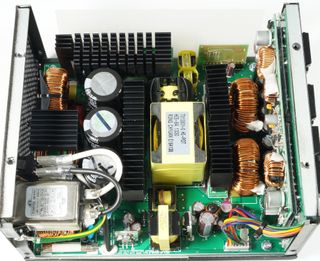Five Highly Efficient Power Supplies: 1200 W and Up
Until recently, buying a PSU with a four-digit wattage was perhaps most useful for boasting among fellow hardware enthusiasts – there was barely any real need for such high wattages. However, Bitcoin mining and Altcoin mining have changed that.
Enermax Platimax 1500 EPM1500EGT

Several times already we have included Enermax Platimax PSUs in various round-up tests, and they always impressed us. Enermax sent us the 230 V version of the Platimax 1500, but a 115 V version should be released shortly. Strictly speaking, a 230 V–only PSU may not carry the 80 Plus Platinum logo, only the newly created 230 V version of this logo. This may be the reason why Enermax didn’t try to have the Platimax 1500 certified. At 5 years, the warranty period of this PSU is the shortest in this test – the four other PSUs offer 7 years warranty.
Like other Platimax models, the flagship model sports a nicely built case with roughened surfaces. At a depth of 7.9”, it is also the smallest case in this round-up test – an amazing feat for a 1500 W PSU. By the way, only the flagship model and the 1350 W model have fully modular cabling. While the motherboard cable and both CPU cables are round, all other cables are flat. There are ten PCIe connectors and 14 SATA plugs – impressive numbers, but in this high-end test field only average. The cable lengths are more or less OK, except for the PCIe cables, which are only 20” long.
While Cooler Master, Corsair, and Seasonic embrace the single rail design, the Enermax supply sports 6 (six!) 12 V rails, each of which can supply up to 30 A. This is less than a quarter of the 125 A on the 12 V rail of the Corsair AX1500i. While a fire inspector may favor the 30 A limit, hardware enthusiasts might feel confined by it. We try not to judge, but we deem short circuits and PC fires unlikely.





| AC Input | 220-240V, 50-60 Hz | |||||||
|---|---|---|---|---|---|---|---|---|
| DC Output | +3.3V | +5V | +12V (#1) | +12V (#2) | +12V (#3) | +12V (#4,5,6) | -12V | +5Vsb |
| 24 A | 24 A | 30 A | 30 A | 30 A | 30 A | 0.5 A | 3 A | |
| Individual Output | Row 2 - Cell 1 | Row 2 - Cell 2 | 32 A | Row 2 - Cell 4 | Row 2 - Cell 5 | 6 W | 15 W | |
| Rail Utilization | Sys | Sys | CPU & VGA | |||||
| Combined Output | 120 W | 1500 W | ||||||
| Total Continuous Output | 1500 W | |||||||
| Peak Output | 1650 W |
Efficiency According to the 80 PLUS Spec

Efficiency for Typical Use Cases

Since the Platimax 1500 PSU only supports 230 V, it is not eligible for the 80 Plus Platinum logo and we didn’t hold it up to the Platinum standard, either. However, we did compare its efficiency at 230 V to other PSUs at 230 V. At low loads, its efficiency numbers are excellent: At 10% load, it achieves 88.7% efficiency. However, at full load, 88.9% is slightly lower than the requirement of the Platinum standard, while the 230 V input voltage should actually help the PSU in making the numbers. Below 10% load, its efficiency drops precipitously – only the Antec HCP-1300 comes in worse. The other test results are OK, but we think that a hold-up time of a mere 18.5 ms is a tad short. However, this value does comply with the ATX spec. Ripple and noise values are OK, but not as good as the excellent values exhibited by the Antec and Corsair PSUs.

The PSU fan’s sound level, however, is a clear opportunity for improvement. We don’t mind that the fan is always on – the Antec HCP-1300 has shown that this is not a problem. No, the Enermax PSU’s fan is simply too noisy. At a mere 40 W power draw, it generates 34.7 dB(A), which is already quite audible in a quiet room. But at 600 W power draw, the fan’s sound level increases to an annoying 40.5 dB(A).
A Closer Look at the PCB
While most manufacturers position the APFC and the primary side of the PSU on the left side and the secondary side on the right, Enermax rotated this layout by 90 degrees and put the primary side at the front and the secondary side at the rear. Enermax expects better cooling performance from this change, and we concur. Apart from this layout change, the electrical design of the PSU is similar to its competitors, and Enermax uses premium components – the primary side capacitors are sourced from Panasonic, and the secondary side ones are manufactured by Rubycon. The soldering quality is good, but there is some room for improvement.

Current page: Enermax Platimax 1500 EPM1500EGT
Prev Page Corsair AX1500i Next Page Seasonic Platinum-1200Stay on the Cutting Edge
Join the experts who read Tom's Hardware for the inside track on enthusiast PC tech news — and have for over 25 years. We'll send breaking news and in-depth reviews of CPUs, GPUs, AI, maker hardware and more straight to your inbox.
-
blackmagnum I respect mother earth and her well-being; I will never hurt her by accepting these gluttonous monstrosities in my gaming builds. Low budget/ low power/ high efficiency FTW!Reply -
kevith Schön, dass Ihr auch deutsche artikeln jetzt schreibt. Das hätte ich mich nie gedacht. Aber was mit alle die amerikanischen leser? Die kann bestimmt kein deutsch?Reply -
damric Much better PSU review than usual for THW.Reply
However, none of these PSUs are as interesting as the SF Leadex. -
Alex Kelly Reply13853559 said:Much better PSU review than usual for THW.
However, none of these PSUs are as interesting as the SF Leadex.
Agreed! That's why I wanted to see the P2 here. -
nikolajj @blackmagnumReply
Well, you don't seem to understand fully.
They don't really consume more power than the connected hardware demands. On the other hand, they have an amazing efficiency rating, meaning that they use a minimum of power, and are therefore better for the planet. ;) -
mapesdhs Pity the Thermaltake Toughpower XT Gold 1475W wasn't included, I've obtainedReply
half a dozen of them recently, excellent PSUs.
Ian.
-
lp231 I still like the interior of my Antec TruePower Quattro 850w. Massive heatsinks!Reply
About that Antec 1300w PSU, according to their site, it says that has a "20+8-pin MBU socket for the needs of tomorrow."
Do you guys have any info on this?
http://store.antec.com/highcurrentpro/hcp-1300-platinum.html -
majormajormajormajor "At the time of writing, the website Plugloadsolutions.com only lists 7 Titanium-grade PSUs: Six models from a company called ‘Super Flower’ and the Corsair AX1500i"Reply
Wow, way to discredit yourself completely. You're reviewing power supplies and you've never heard of Super Flower?